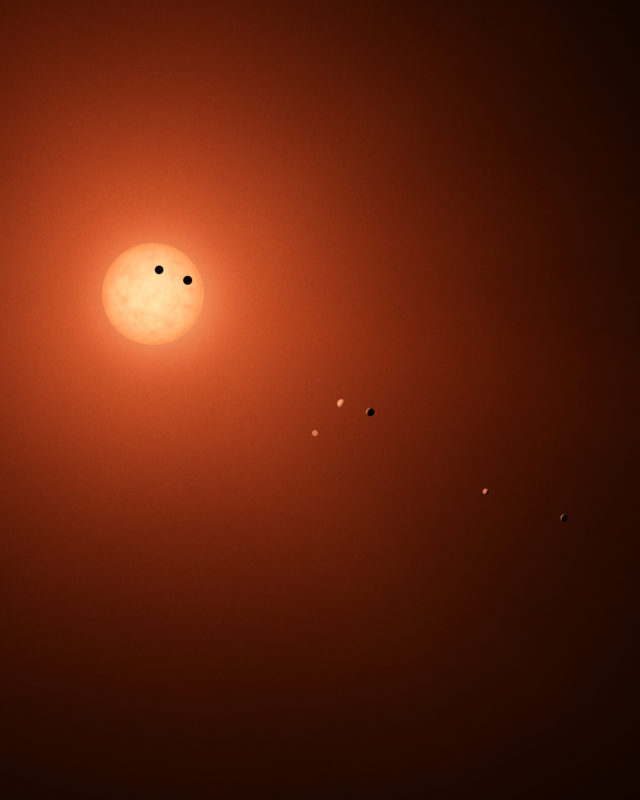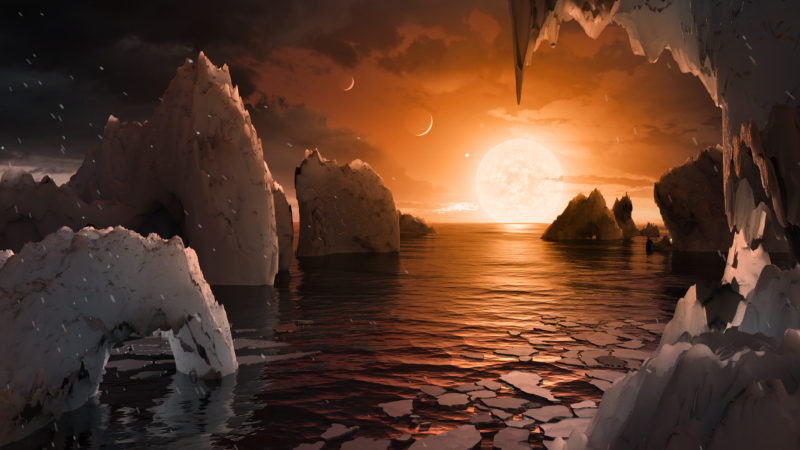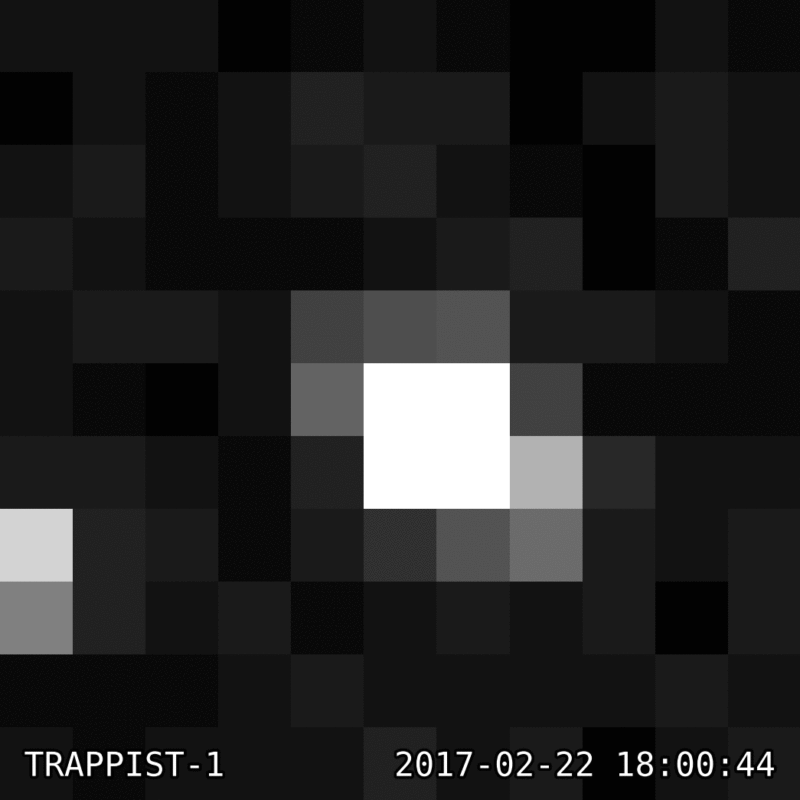March 19, 2017 10:00 pm
So, What Are the Odds of Life in the TRAPPIST-1 System?
A rational analysis of what we know and what we don’t
Today’s guest blog post is by StarTalk intern Kirk Long. Kirk is majoring in physics while minoring in mathematics and piano at Idaho State University.
A few weeks ago NASA got everyone (including me) very excited when they announced the discovery of 7 earth-sized planets orbiting a single red dwarf star 39.5 ±1.3 light-years away. This was a monumental discovery—the first exoplanet system to have this many potentially Earth-like worlds in one place, three of which are within the star’s so called “habitable” zone. You’ve probably heard all this before in the thousands of media headlines proclaiming NASA had discovered three sister Earths, but now that the dust has settled and we can better analyze the facts, what are the odds that life could really be there? I dug into the research discussed in two prominent papers on the TRAPPIST-1 system, and have done my best to interpret the data for our readers.

An artist’s depiction of the TRAPPIST-1 system. Credit: NASA/JPL-Caltech/R. Hurt (IPAC).
The Problem: TRAPPIST-1 is more exciting than our Sun
Although the TRAPPIST-1 planets may be similar in size and radius to Earth, the star that they orbit is nowhere near an analogue for our own sun. Our sun is a pleasant, rather boring star, sitting pretty much straight in the middle of main sequence stars. Our sun will not do anything particularly cool in its lifetime (like go supernova or turn into a black hole) but it turns out that those kinds of things are not great for fostering the conditions for life to evolve, so we should really be grateful for its banality. The TRAPPIST-1 star, however, is significantly smaller than our own sun. In fact, a better analogue for the TRAPPIST-1 system might be the Jovian system than the entire solar system—TRAPPIST-1 and Jupiter both have radii only about a tenth of our sun’s, although TRAPPIST-1 is significantly denser than Jupiter, which is why TRAPPIST-1 is a star and Jupiter is not. As a result of its smaller size, its surface temperature is a little more than 3,000 degrees Kelvin cooler than the surface of our own sun and its luminosity just 0.05% of our star’s. Thus, for the planets to be inside the star’s “habitable” or “Goldilocks” zone—the area where liquid water could exist on a planetary surface—the TRAPPIST-1 planets must orbit significantly closer to their host star than the distance the Earth orbits the Sun. In fact, the entire TRAPPIST-1 system would fit well within the orbit of Mercury, which is one of the reasons a better analogue might be the Jovian system.
These incredibly tight orbits mean that the planets are probably tidally locked—meaning that one side of each planet would permanently face the star, similar to how the same face of the moon always faces the Earth (the authors of the paper do suggest that although they are pretty sure they are tidally locked, they also present an alternate scenario where the planets are trapped in a “higher-order spin-orbit resonance”). This means that there are probably incredible temperature discrepancies on the day and night sides, which (assuming they have atmospheres) would create intense winds and currents, making it much more difficult for life to evolve. The best chances life would have to evolve would probably be near the terminator—the divide between the light and dark sides—where neither the heat nor cold would be too extreme.
Another perk of orbiting a boring star is that its emission of other, more harmful radiation like X-rays is low enough that it doesn’t cause too much of a problem for life here on Earth. Unfortunately, this is not the case around TRAPPIST-1, where researchers have found that it emits about as much X-ray radiation as the Sun does despite being only about 1/12th of its mass. There’s a great paper on this phenomenon you can read here, but basically researchers concluded that the TRAPPIST-1 planets would experience irradiation levels “tens to over a thousand times higher than experienced by the present-day Earth.” Solar radiation interacts and energizes particles in a planet’s atmosphere, and although a planet’s magnetic field can help shield and divert some of this radiation, if the field is not strong enough or the radiation stream too strong models indicate that atmospheres are “blown away” by the stellar wind (this is actually one hypothesis for why Mars doesn’t have a strong atmosphere—researchers think that when its magnetic field died the solar wind quickly eroded an early Martian atmosphere and left it uninhabitable).

Here an artist depicts what it would be like to stand on the surface of TRAPPIST-1f, the 5th planet from the star. The larger object in the sky would be TRAPPIST-1e, the middle crescent is TRAPPIST-1d, and the dot just left of the star TRAPPIST-1c. Credit: NASA/JPL-Caltech/T. Pyle (IPAC).
These tight orbits also mean the TRAPPIST-1 planets are much closer to each other than planets in our own solar system are (if you were on the surface of one of the inner planets you might see some of the others like “moons” in the hypothetical night sky, as depicted in NASA’s artist illustration above). This means that they tug and pull on each other, creating slight variations in their orbits but also constantly stretching and contracting each other. This could lead to increased levels of geologic activity that might not be good for life, although it does introduce the possibility of there being life outside of the “habitable” zone—tidal heating could allow for a Europa-style subsurface ocean that might be hospitable to life. If life does exist even on just one of the TRAPPIST-1 planets, however, these tight orbits would significantly increase the chances for diverse life on others in the system. The panspermia theory for how primordial life evolved on Earth is that it came from Mars, hitchhiking on ancient meteorites. The chances of life propagating in the TRAPPIST-1 system via a similar mechanism would be much higher than they are in our solar system, and would certainly be fascinating to study should we ever manage to get there.

This is what TRAPPIST-1 actually looks like, to our best telescopes available. None of the planets are directly visible, and NASA says that this image comes from an area in the sky equivalent to the apparent size of a grain of sand held in an outstretched hand. This is why we need the James Webb Space Telescope, and why we are so excited for its launch next year!
All this isn’t meant to say that there isn’t life on one of the TRAPPIST-1 worlds, but instead a reminder that we should temper our expectations and eagerly await more data. When the James Webb Space Telescope launches in 2018 one of its first targets will be further observation of the TRAPPIST-1 system, and with those observations we may be able to tell whether the planets do indeed have atmospheres and gain clues as to what their composition might be. TRAPPIST-1 is an incredibly promising and exciting discovery, but given the data we have right now I’d probably wager against the existence of life there, and would certainly wager against the existence of anything more complicated than microbial life. This is why astronomers everywhere are awaiting the launch of the James Webb Space Telescope, which will be the largest space telescope ever constructed—Hubble is certainly great for the wonderful relatively true-color images it provides, but James Webb will allow us to better image everything from exoplanets to the beginning of the universe itself. I’d love to be proven wrong down the road, and as we collect more data maybe I will be, but either way it is certainly fascinating to contemplate the dynamics of a solar system less than 40 light years away (as Douglas Adams said, “that’s peanuts to space”).
What are your thoughts on TRAPPIST-1, and where do you think we’ll find life in the cosmos?
Get the most out of StarTalk!
Ad-Free Audio Downloads
Priority Cosmic Queries
Patreon Exclusive AMAs
Signed Books from Neil
Live Streams with Neil
Learn the Meaning of Life
...and much more

 Become a Patron
Become a Patron

